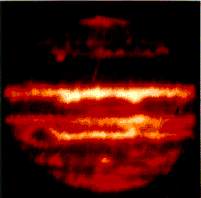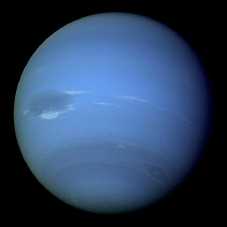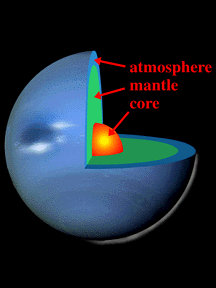This is a drawing of the interior of Neptune.
Click on image for full size
A Look at the Inside of Neptune
The Giant planets do not have the same kind of layers inside that the Earth-like planets do. The history of the giant planets was so different that they formed with much more gas and ice on the inside.
Motions in the interior of Neptune help form the magnetosphere of Neptune. Heat generated within Neptune helps form the unusual winds of the atmosphere.
You might also be interested in:

Motions in the interior of a planet help to move heat from the inside to the outside. The drawing shows a kind of movement that is usual in the atmosphere as well as the inside of a planet. Material moves
...more
The picture shows places on Jupiter which are hot. Jupiter is a very warm place, as shown in the picture, sort of like a warm log in the fireplace which gives off heat. Like Jupiter, Neptune also gives
...more
Motions in the interior of a gas-giant planet such as Neptune may be very different from the motions within the Earth. A second idea for the motions in the interior of a gas-giant planet is shown in this
...more
Neptune was discovered in 1846. But it wasn't discovered using a telescope. Scientists used math instead! They watched Uranus and saw that its orbit was doing weird things. They knew another planet had
...more
Neptune's atmosphere shows a striped pattern of clouds, just like that of Jupiter and Saturn. Neptune even has a Great Dark Spot similar to the Great Red Spot of Jupiter. The history of Neptune's atmosphere
...more
This image shows the new Great Dark Spot of Neptune, which was discovered using the Hubble Space Telescope. The image shown here, shows a large "hole" in the clouds of Neptune in pink, in the northern
...more
The giant planets have definitely changed since their formation. But how much remains to be seen. Most of the original air of the giant planets remains in place. (The earth-like planets lost most of their
...more
This image shows some clouds known as "cirrus" clouds, extending for many kilometers across the face of Neptune. These clouds are very high up, for they can be seen to cast shadows on the lower clouds,
...more














